MVC中使用Web API和EntityFramework
2021-02-12 22:20
最近做了一个项目技术预研:在ASP.NET MVC框架中使用Web API和EntityFramework,构建一个基础的架构,并在此基础上实现基本的CRUD应用。
以下是详细的步骤。
第一步
在数据库中创建一张数据表,表名为Customer,见下图:
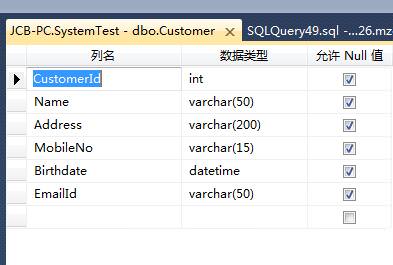
第二步
-
打开 Visual Studio,新建项目。
-
选择‘ASP.NET Web Application‘,命名为‘WebApi‘。

-
我们要创建一个‘Web API‘,在模板中选择‘Web API‘,点击‘确定‘。
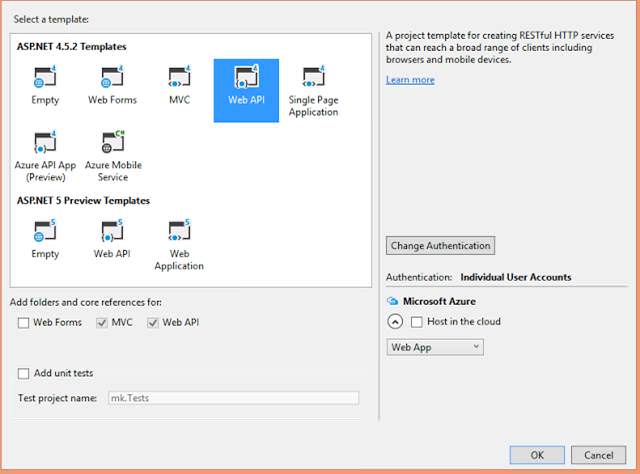
第三步
接下来我要添加一个类。
-
右键点击这个 web api项目,添加一个‘ADO.NET Entity Data Model‘。
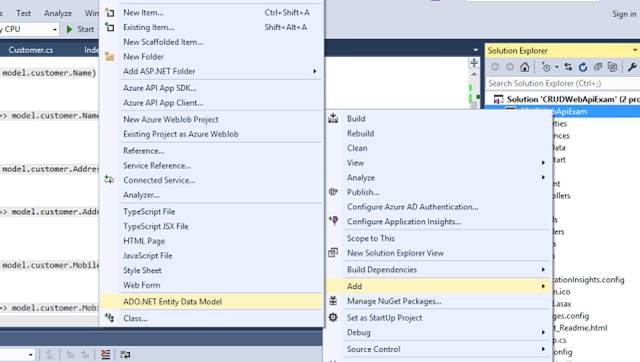
-
添加‘EF Designer from database‘,点击‘下一步‘。
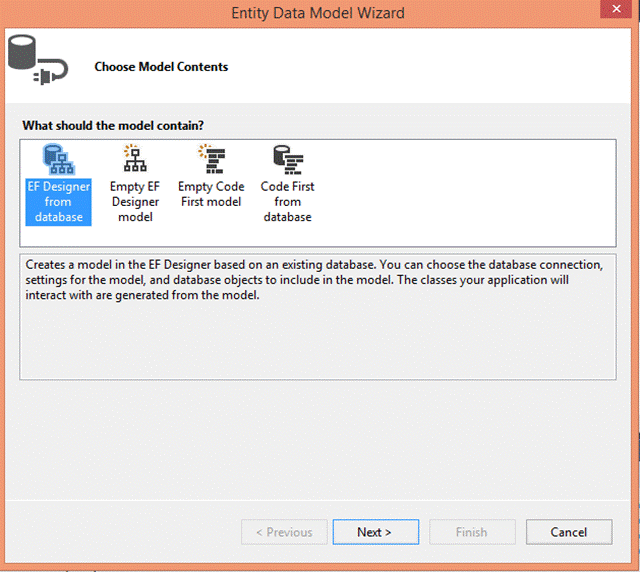
-
在配置窗口中添加新连接,输入服务器名称,选择数据库,点击‘确定‘。

-
点击‘下一步‘,选择要关联的数据表。
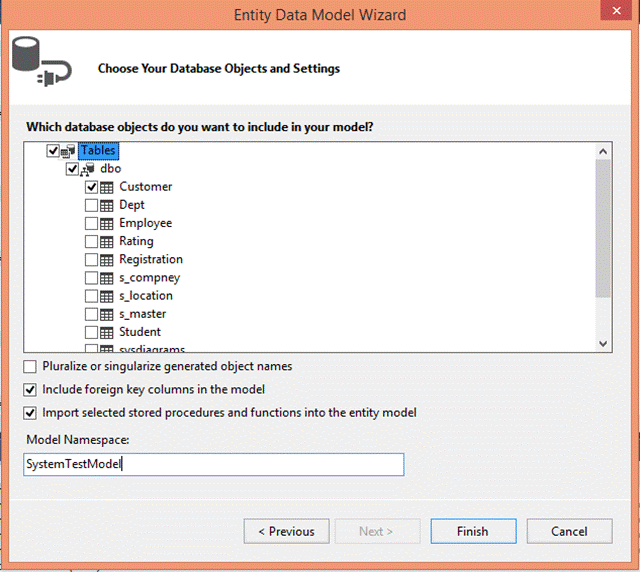
-
点击‘完成‘。
第四步
现在的工作就是要为Wep Api添加控制器了。
-
右键选择‘controllers‘文件夹。
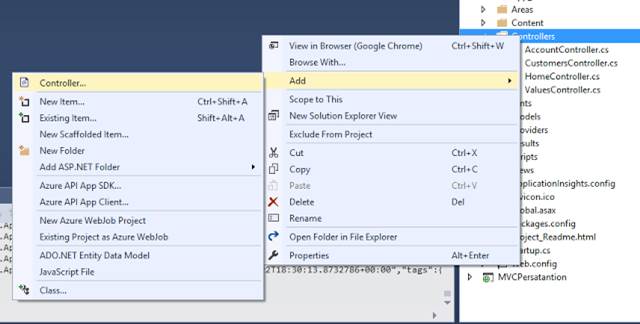
-
选择‘MVC5 Controller with views, using Entity Framework‘。
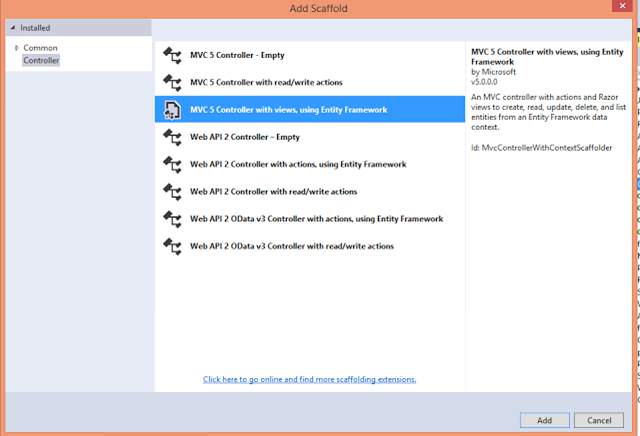
-
点击‘添加‘。
-
选择数据模型类Customer,选择Data context类文件,本例中为SystemTestEntity。
-
设置控制器名称为CustomersController,点击‘添加‘。
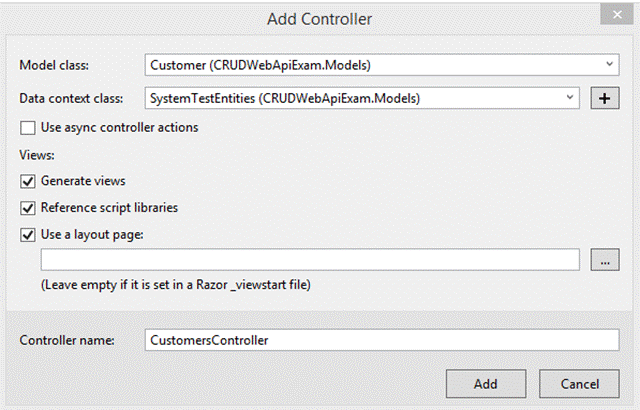
上述操作完成后,CustomerController.cs会自动生成。
CustomerController.cs
using System.Data.Entity;
using System.Data.Entity.Infrastructure;
using System.Linq;
using System.Net;
using System.Web.Http;
using System.Web.Http.Description;
using CRUDWebApiExam.Models;
namespace CRUDWebApiExam.Controllers
{
public class CustomersController : ApiController
{
private SystemTestEntities db = new SystemTestEntities();
// GET: api/Customers
public IQueryableGetCustomer()
{
return db.Customer;
}
// GET: api/Customers/5
[ResponseType(typeof(Customer))]
public IHttpActionResult GetCustomer(int id)
{
Customer customer = db.Customer.Find(id);
if (customer == null)
{
return NotFound();
}
return Ok(customer);
}
// PUT: api/Customers/5
[ResponseType(typeof(void))]
public IHttpActionResult PutCustomer(int id, Customer customer)
{
if (!ModelState.IsValid)
{
return BadRequest(ModelState);
}
if (id != customer.CustomerId)
{
return BadRequest();
}
db.Entry(customer).State = EntityState.Modified;
try
{
db.SaveChanges();
}
catch (DbUpdateConcurrencyException)
{
if (!CustomerExists(id))
{
return NotFound();
}
else
{
throw;
}
}
return StatusCode(HttpStatusCode.NoContent);
}
// POST: api/Customers
[ResponseType(typeof(Customer))]
public IHttpActionResult PostCustomer(Customer customer)
{
if (!ModelState.IsValid)
{
return BadRequest(ModelState);
}
db.Customer.Add(customer);
db.SaveChanges();
return CreatedAtRoute("DefaultApi", new { id = customer.CustomerId }, customer);
}
// DELETE: api/Customers/5
[ResponseType(typeof(Customer))]
public IHttpActionResult DeleteCustomer(int id)
{
Customer customer = db.Customer.Find(id);
if (customer == null)
{
return NotFound();
}
db.Customer.Remove(customer);
db.SaveChanges();
return Ok(customer);
}
protected override void Dispose(bool disposing)
{
if (disposing)
{
db.Dispose();
}
base.Dispose(disposing);
}
private bool CustomerExists(int id)
{
return db.Customer.Count(e => e.CustomerId == id) > 0;
}
}
} 运行这个 Web Api项目,你会看到下面的结果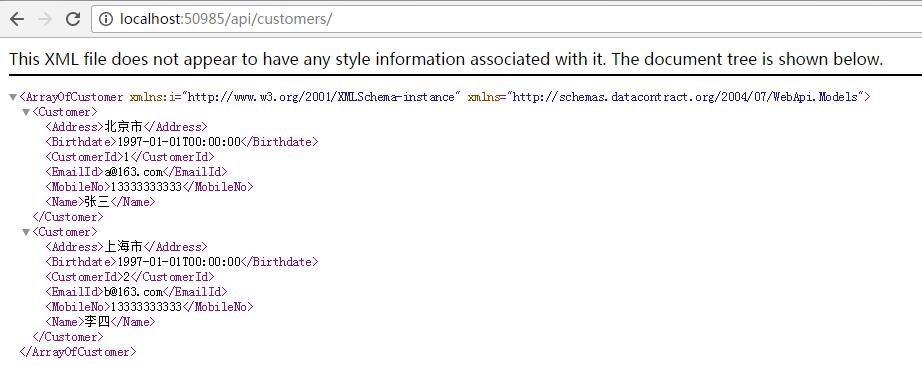
第五步
到此为止,web api已经构建成功了。接下来我们需要为这个web api服务添加消费对象了,这个消费对象就是本文要涉及的MVC项目。
- 首先要添加一个model类,我们可以直接采用上文中的Customer类。右键点击models文件夹,添加类并命名。本例中,我直接命名为Customer.cs。
Customer.cs
using System;
using System.ComponentModel.DataAnnotations;
namespace MVCPersatantion.Models
{
public class Customer
{
[Display(Name = "CustomerId")]
public int CustomerId { get; set; }
[Display(Name = "Name")]
public string Name { get; set; }
[Display(Name = "Address")]
public string Address { get; set; }
[Display(Name = "MobileNo")]
public string MobileNo { get; set; }
[Display(Name = "Birthdate")]
[DataType(DataType.Date)]
public DateTime Birthdate { get; set; }
[Display(Name = "EmailId")]
public string EmailId { get; set; }
}
} - customer类添加完成后,接下来需要添加一个ViewModel文件夹,并在里面新建一个CustomerViewModel.cs文件。
CustomerViewModel.cs
using MVCPersatantion.Models;
namespace MVCPersatantion.ViewModel
{
public class CustomerViewModel
{
public Customer customer { get; set; }
}
}第六步
我已经添加了一个消费web api服务的类,现在我还需要添加一个Client类。
- 右键点击models文件夹,添加类文件CustomerClient.cs。
CustomerClient.cs
using System;
using System.Collections.Generic;
using System.Net.Http;
using System.Net.Http.Headers;
namespace MVCPersatantion.Models
{
public class CustomerClient
{
private string Base_URL = "http://localhost:30110/api/";
public IEnumerablefindAll()
{
try
{
HttpClient client = new HttpClient();
client.BaseAddress = new Uri(Base_URL);
client.DefaultRequestHeaders.Accept.Add(new MediaTypeWithQualityHeaderValue("application/json"));
HttpResponseMessage response = client.GetAsync("customers").Result;
if (response.IsSuccessStatusCode)
return response.Content.ReadAsAsync>().Result;
return null;
}
catch
{
return null;
}
}
public Customer find(int id)
{
try
{
HttpClient client = new HttpClient();
client.BaseAddress = new Uri(Base_URL);
client.DefaultRequestHeaders.Accept.Add(new MediaTypeWithQualityHeaderValue("application/json"));
HttpResponseMessage response = client.GetAsync("customers/" + id).Result;
if (response.IsSuccessStatusCode)
return response.Content.ReadAsAsync().Result;
return null;
}
catch
{
return null;
}
}
public bool Create(Customer customer)
{
try
{
HttpClient client = new HttpClient();
client.BaseAddress = new Uri(Base_URL);
client.DefaultRequestHeaders.Accept.Add(new MediaTypeWithQualityHeaderValue("application/json"));
HttpResponseMessage response = client.PostAsJsonAsync("customers", customer).Result;
return response.IsSuccessStatusCode;
}
catch
{
return false;
}
}
public bool Edit(Customer customer)
{
try
{
HttpClient client = new HttpClient();
client.BaseAddress = new Uri(Base_URL);
client.DefaultRequestHeaders.Accept.Add(new MediaTypeWithQualityHeaderValue("application/json"));
HttpResponseMessage response = client.PutAsJsonAsync("customers/" + customer.CustomerId, customer).Result;
return response.IsSuccessStatusCode;
}
catch
{
return false;
}
}
public bool Delete(int id)
{
try
{
HttpClient client = new HttpClient();
client.BaseAddress = new Uri(Base_URL);
client.DefaultRequestHeaders.Accept.Add(new MediaTypeWithQualityHeaderValue("application/json"));
HttpResponseMessage response = client.DeleteAsync("customers/" + id).Result;
return response.IsSuccessStatusCode;
}
catch
{
return false;
}
}
}
} 细心的朋友们可能已经发现,我的代码中有一些重复代码。实际应用中我们可以抽取成公用代码,这样任何地方都能够使用了。这里为了清楚的阐述过程,所以写了一些重复的代码。
我们看第一行private string Base_URL = "http://localhost:50985/api/",这个Base_URL是web api的服务地址。
接下来就可以编写Insert、Update、Delete、Select的业务逻辑了。
第七步
右键点击Controllers文件夹,添加一个名为Customer控制器,控制器中添加服务客户端调用的方法。
using System;
using System.Collections.Generic;
using System.Linq;
using System.Web;
using System.Web.Mvc;
using MVCPersatantion.Models;
using MVCPersatantion.ViewModel;
namespace MVCPersatantion.Controllers
{
public class CustomerController : Controller
{
// GET: Customer
public ActionResult Index()
{
CustomerClient CC = new CustomerClient();
ViewBag.listCustomers = CC.findAll();
return View();
}
[HttpGet]
public ActionResult Create()
{
return View("Create");
}
[HttpPost]
public ActionResult Create(CustomerViewModel cvm)
{
CustomerClient CC = new CustomerClient();
CC.Create(cvm.customer);
return RedirectToAction("Index");
}
public ActionResult Delete(int id)
{
CustomerClient CC = new CustomerClient();
CC.Delete(id);
return RedirectToAction("Index");
}
[HttpGet]
public ActionResult Edit(int id)
{
CustomerClient CC = new CustomerClient();
CustomerViewModel CVM = new CustomerViewModel();
CVM.customer = CC.find(id);
return View("Edit",CVM);
}
[HttpPost]
public ActionResult Edit(CustomerViewModel CVM)
{
CustomerClient CC = new CustomerClient();
CC.Edit(CVM.customer);
return RedirectToAction("Index");
}
}
} 第八步
-
创建视图页面Index.cshtml。
-
在Index页面中添加代码。
Index.cshtml
@{
ViewBag.Title = "Index";
}
h2>Indexh2>
div align="center">
@Html.ActionLink("Create", "Create", "Customer", new { area = "" }, null)
br />br />
table cellpadding="2"
class="table"
cellspacing="2"
border="1">
tr class="btn-primary">
th>
CustomerId
th>
th> Nameth>
th> Addressth>
th> MobileNoth>
th> Birthdateth>
th> EmailIdth>
th> Actionth>
tr>
@foreach (var Cust in ViewBag.listCustomers)
{
tr class="btn-success">
td>
@Cust.CustomerId
td>
td>
@Cust.Name
td>
td>
@Cust.Address
td>
td>
@Cust.MobileNo
td>
td>
@Cust.Birthdate.ToString("dd/MM/yyyy")
td>
td>
@Cust.EmailId
td>
td>
a onclick="return confirm(‘确定要删除这条数据?‘)"
href="@Url.Action("Delete","Customer",new {id= Cust.CustomerId})">Deletea> ||
a href="@Url.Action("Edit","Customer",new {id= Cust.CustomerId})">Edita>
@*@Html.ActionLink("Edit", "Edit", "Customer", new { id = Cust.CustomerId })*@
td>
tr>
}
table>
div>-
添加新增数据模块Create。
-
在Customer控制器中添加create方法,在view中增加Create.cshtml。
Create.cshtml
@model WebApiMVC.ViewModel.CustomerViewModel
@{
ViewBag.Title = "Create";
}
h2>Createh2>
div align = "center" >
@using (Html.BeginForm("create", "Customer", FormMethod.Post))
{
table class="table">
tr>
td>
@Html.LabelFor(model => model.customer.Name)
td>
td>
@Html.TextBoxFor(model => model.customer.Name)
td>
tr>
tr>
td>
@Html.LabelFor(model => model.customer.Address)
td>
td>
@Html.TextBoxFor(model => model.customer.Address)
td>
tr>
tr>
td>
@Html.LabelFor(model => model.customer.MobileNo)
td>
td>
@Html.TextBoxFor(model => model.customer.MobileNo)
td>
tr>
tr>
td>
@Html.LabelFor(model => model.customer.Birthdate)
td>
td>
@Html.TextBoxFor(model => model.customer.Birthdate)
td>
tr>
tr>
td>
@Html.LabelFor(model => model.customer.EmailId)
td>
td>
@Html.TextBoxFor(model => model.customer.EmailId)
td>
tr>
tr>
td>td>
td>
input type="submit" value="保存" />
td>
tr>
table>
}
div>
-
添加修改数据模块Edit。
-
在Customer控制器中添加edit方法,在view中增加Edit.cshtml。
Edit.cshtml
@{
ViewBag.Title = "Edit";
}
@model WebApiMVC.ViewModel.CustomerViewModel
h2> Edit h2>
div align="center" width="500px">
@using (Html.BeginForm("Edit", "Customer", FormMethod.Post))
{
table class="table"
width="400px"
cellpadding="20">
tr class="btn-default">
td>
@Html.LabelFor(model => model.customer.Name)
td>
td>
@Html.TextBoxFor(model => model.customer.Name)
td>
tr>
tr>
td>
@Html.LabelFor(model => model.customer.Address)
td>
td>
@Html.TextBoxFor(model => model.customer.Address)
td>
tr>
tr>
td>
@Html.LabelFor(model => model.customer.MobileNo)
td>
td>
@Html.TextBoxFor(model => model.customer.MobileNo)
td>
tr>
tr>
td>
@Html.LabelFor(model => model.customer.Birthdate)
td>
td>
@Html.TextBoxFor(model => model.customer.Birthdate)
td>
tr>
tr>
td>
@Html.LabelFor(model => model.customer.EmailId)
td>
td>
@Html.TextBoxFor(model => model.customer.EmailId)
td>
tr>
tr>
td> td>
td>
input type="submit" value="保存" /> a class="btn-primary" href="@Url.Action("Index ","Customer ")"> 返回 a>
@Html.HiddenFor(model => model.customer.CustomerId)
td>
tr>
table>
}
div>
最终项目代码已经完成了。这时候我们运行项目试试看了。但还有一点要注意的是,我们必须同时运行web api和mvc项目。怎么办呢?其实只要在项目属性里设置就可以了。
- 右键解决方案,选择属性(Properties)。
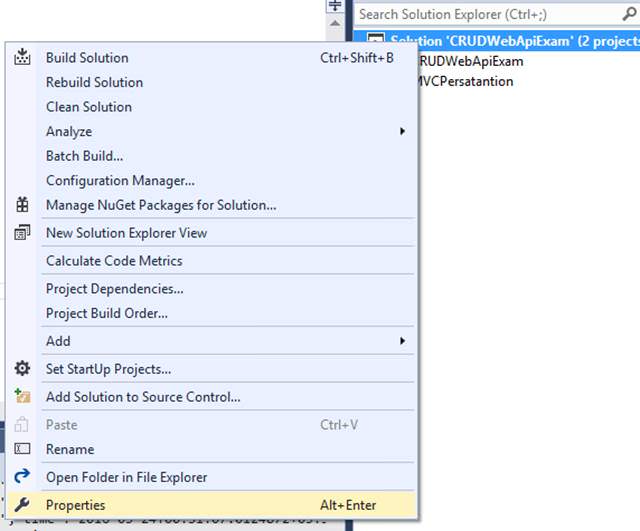
-
接来下在启动项目选项中,选择
多项目启动,在Action中设置两个项目同时启动。 -
运行项目,看看CRUD操作的执行结果。
Select
Insert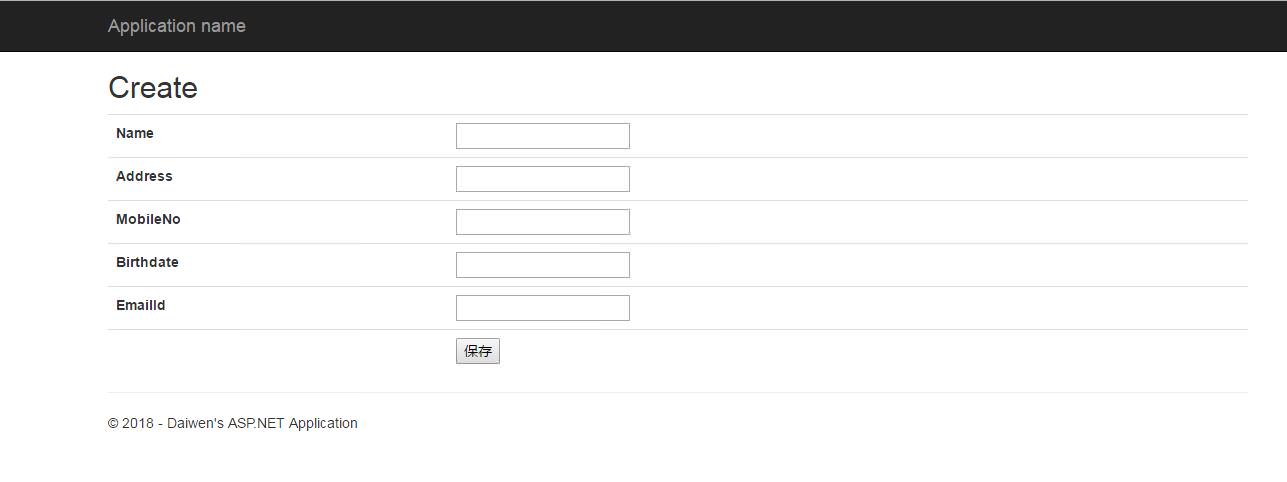
Update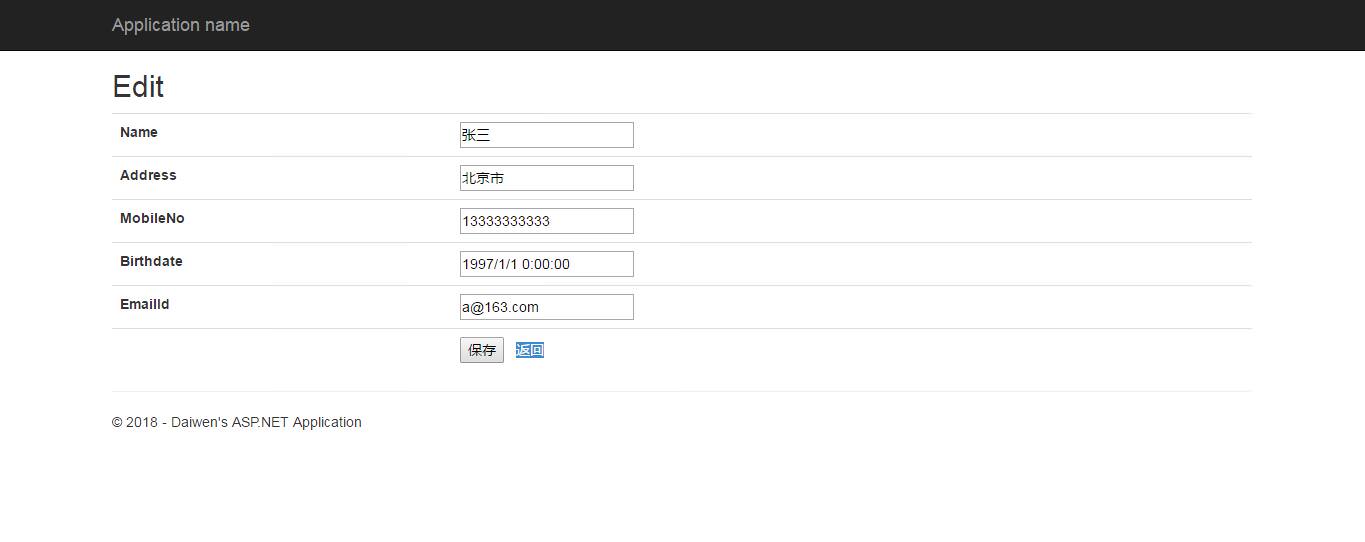
Delete
这是整个技术预研的过程,本文末尾位置提供代码下载。
博客地址:http://www.cnblogs.com/yayazi/
文章标题:MVC中使用Web API和EntityFramework
文章链接:http://soscw.com/essay/54645.html